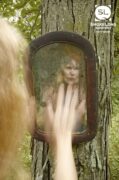You are a novelist, poet, and essayist. As someone who writes in multiple genres, what was it about “What You Owe” that made you think flash?
Art tells you how to make it. This story didn’t need much space. It was really a small explosion, and to extend it, I feel, would be to ruin its power. I feel like art needs to hurt you at the end. You need to feel changed having read or seen it, and to want more from it, even if it hurts (and maybe the hurt is that it’s over, no more is coming). I have focused, the last few years, on writing novels and nonfiction/journalism, because that’s how I can support myself and my family financially. But I wish I had more time to write short stories. I think that’s the hardest form of writing—knowing how far to go but no more—and the one I admire the most.
Reading (and rereading) your wonderful story, I am continually struck by your precision and restraint, the weight of every line and half line from “You lost?” to “I’m not taking—” how it all hews closely to the imperative, and I wonder, does it just spring forth like that? Or do you write long and then pare down? What’s your process like?
I knew this story was going to be short because it’s really just one moment, plus memory and feeling. I am fascinated by single mistakes, one move that changes everything. The strongest stories are quite simple when you get down to it: loving or angering the wrong person, getting lost, catching the wrong person’s eye. One mistake can shift or end a life or set in motion a chain reaction that does. I think about my training as an actor and the idea of deliberate actions: not being sloppy on stage, but making every movement count, being purposeful. My novel really has three major actions: girl leaves home, girl meets a bad man, bad man follows. I tend to edit severely. It’s easier for me to pare down than it is to add more later, maybe when I’m not in the same headspace. So I write as much as I possibly can in first drafts of novels, for instance, then the real essential parts reveal themselves in revision. My current novel-in-progress started out as 111,000 words! Not to terrify my editor, if she’s reading this—it’s presently a manageable (?) 94,000.
The world of “What You Owe” makes me think of Dorothy Allison’s essay “On Place.” Allison says, “Place is people with desire.” And one of the remarkable things about your story is how palpable place and desire are from the start, how interwoven. How do you approach place in your work?
I think place has a big influence on my work the way place had a big influence on me, on my life. My work changed when I moved to Appalachian Ohio over a decade ago. I grew up slightly north in a more Rust Belt Ohio town. Living here in the poorest county of the state changes you, the way that being poor changes the brain. For the rest of my life I will always calculate how much the food in my grocery cart costs as I’m shopping, for instance; I’m usually within a dollar. Place is a character, but more than that, place is a calling. Some places really stay with you. They call you back, call you home, even as they hurt you, and Appalachian Ohio is definitely like that. The intertwining of pain and sorrow and frustration with a place along with your deep love, respect, and longing for it, I think that’s always in my work.
To me, “What an opportunity you have, to know this suffering” is an ironic takeaway of this story. How Larch misses it completely—he exploits, and is haunted by his exploitation, the theft of the moment, his fetishization of poverty as stand-in for the scarcity that defines his relationship with Kristen. He may fetishize these women and their home, but the true poverty of the heart lies with Larch and his failure to love. He takes and he takes and remains empty. What do you we continue to get wrong about regional poverty?
I can’t speak for every part of the region of course, and I can only speak from my own experience. As a white woman who passes for abled, straight, and younger than I am, I know I am treated better than other single mothers who are not white, for example. But there are errors consistently spread about central Appalachia, often from people with no lived experience here: the idea that people commit benefits fraud (it’s extremely complicated, overwhelming so, and everything is digital, so fraud is extremely unlikely if not impossible—and it’s not uncommon for people to die waiting for disability benefits, it takes so long). The idea that people are lazy is another falsehood. Appalachians are the hardest-working people I have ever met. All of my friends and neighbors work multiple jobs. They also give in a way that has fundamentally changed me and shaped my son, who was born here. In my experience, people who have the least give the most. I wish people wrote more about neighbors helping neighbors, about the sustainability and resilience of Appalachia. I wish people looked more to Appalachian for climate change solutions, for innovations, as well as hired Appalachians for writing about lived, on-the-ground experiences, especially as we move into the next election cycle.
Your debut novel, Road Out of Winter, is coming out this year, with another novel on its heels in 2021. How does this story fit in with your other work?
I think everything I write is set in the same world, loosely based on my own. My novel out in September, Road Out of Winter, is about a young woman who has grown up working on her family’s illegal marijuana grow in rural Appalachian Ohio. When spring doesn’t come for the second year in a row, well, everything changes. She leaves the farm, assembles a chosen family, and becomes the target of a violent man. My novels are more plot-driven than my other work, but it’s important for me that writing is entertaining and beautiful. When I read a novel in particular, I like to be scared. I like to be kept up late at night. So I try to keep readers up late, too. The novels I write are stand-alone. My next book is not a sequel to Road Out of Winter, but it’s set in the same region, central Appalachia—just about seventy-five years in the future. Things have gotten … worse, as they do. And people are trying their best, as they do. I often feel like I’m the absent mother in things I write, and that all the people throughout genres are circling the same spot. Maybe they pass each other in the grocery store but they don’t know each other by name. Maybe they all drink from the same well. Even if the setting is more speculative, as my novels are, intergenerational poverty and resilience are the bedrock. I just want to center the place I live, even tangentially, because I think it’s important. I just want to write about experiences of poverty and disability because I think they matter.



 The core workshop of SmokeLong Fitness is all in writing, so you can take part from anywhere at anytime. We are excited about creating a supportive, consistent and structured environment for flash writers to work on their craft in a community. We are thrilled and proud to say that our workshop participants have won, placed, or been listed in every major flash competition. Community works.
The core workshop of SmokeLong Fitness is all in writing, so you can take part from anywhere at anytime. We are excited about creating a supportive, consistent and structured environment for flash writers to work on their craft in a community. We are thrilled and proud to say that our workshop participants have won, placed, or been listed in every major flash competition. Community works.